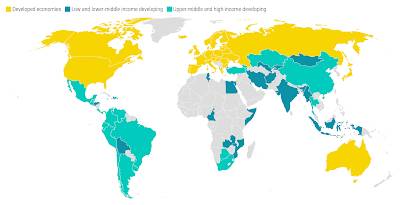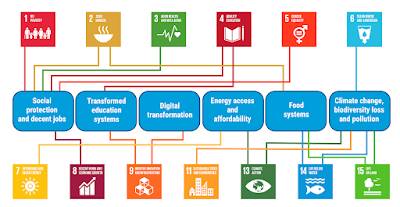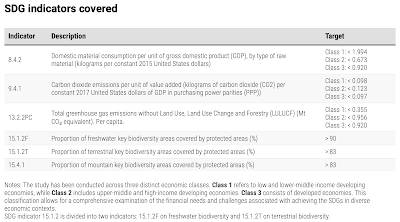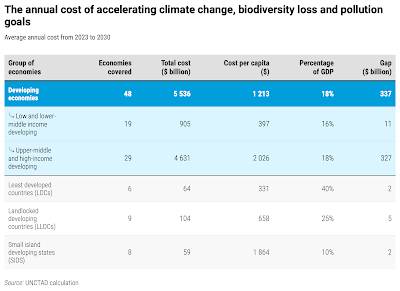
The High Cost of Climate Change Mitigation for Developing Economies
What our politicians rarely mention is that there will be a very high cost to their drive to bring the net zero narrative to fruition. A study by the United Nations Conference on Trade and Development (UNCTAD) outlines the high cost of the fight against climate change for developing economies, numbers which should cause concern for those often impoverished citizens living in these nations.
Let’s start with some background first. As noted above, the analysis looks at two main global economies, developed and developing economies which are shown on this map:
The estimates of this study calculated climate change mitigation costs for over 90 economies which represent 72 percent of the global population. This includes 48 developing economies with 19 of these being classified as low- and lower-middle income and 29 being classified as upper-middle and high-income which, in total, covers 68 percent of people living in developing economies worldwide.
UNCTAD looks at six “transition pathways” to achieve it 2030 Agenda for Sustainable Development as shown here:
For the purposes of this posting, we’ll focus on the “Climate change, biodiversity loss and pollution” pathway which “includes strengthening commitments under the Paris Agreement, improving ecosystem management, reducing the effects of disasters and integrating climate and biodiversity actions.”
The study covers several of the United Nations Sustainable Development Goals or SDGs related to climate change including the following indicators:
The United Nations measures progress on this SDG in several areas; safeguarding marine, freshwater and land biodiversity; bolstering the sustainability of fisheries; increasing forest coverage; preventing land degradation; and halting the extinction of threatened species.
Now, let’s look at the numbers. The total annual cost of accelerating climate change, biodiversity loss and pollution goals between 2023 and 2030 for developing economies is $5.536 trillion or 18 percent of their GDP. The per capita cost ranges from $397 annually for low and lower-middle income developing nations and $2026 annually for upper-middle and high-income developing nations with an average of $1213 per person annually for all developing nations.
Here is a table summarizing the findings of the study:
What concerns UNCTAD is the spending gap on the climate change sustainable development goal by these nations; the authors of the study note that there is a $337 billion annual funding gap which would require a 6.5 percent increase in annual spending. What’s even more concerning to the United Nations is, that if all developing economies are included, the total annual spending on the climate change SDG would reach up to $7 trillion meaning that the annual gap would be $410 billion.
Fortunately for all of us, the United Nations has provided recommendations as quoted here:
“Government spending can be tailored to specific national circumstances. These might include enhancing environmental planning and regulation, building climate-resilient infrastructure, promoting clean technologies like carbon capture, developing early warning systems, or restoring and conserving forests and marine life.“
Keeping in mind that the developing economies included in these calculations have some of the poorest people on earth, it boggles the mind that the United Nations would think that the indebted governments in these nations would have the funding to actually meet the United Nations’ climate change sustainable development goals when they struggle to feed their own citizens.




Be the first to comment